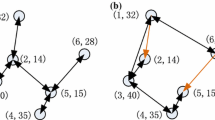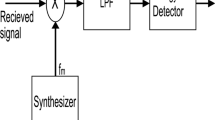Abstract
In this paper, we investigate power allocation in cognitive sensor networks, where cognitive users (cognitive enabled sensor nodes) opportunistically share the common spectrum with primary users (licensed devices). Consider that sensor nodes are self-interested to maximize their own utilities, we formulate the energy-efficient power allocation problem as a non-cooperative coupled constraint game, by taking the interference temperature into account. An energy efficiency-oriented utility function is defined as a new metric to evaluate the performance of power allocation. Firstly, we prove that there exist Nash equilibriums in the proposed game. Then, we prove that the power allocation game is a super-modular game under some conditions. Finally, we design centralized and distributed Game-based Efficiency-oriented Power Allocation algorithms (i.e., centralized GEPA and distributed GEPA) to obtain the Nash equilibriums. Extensive simulations are conducted to demonstrate that the proposed power allocation algorithms can achieve satisfactory performance in terms of energy efficiency, convergence speed and fairness in cognitive sensor networks.










Similar content being viewed by others
References
Chai, B., Deng, R., Cheng, P., & Chen, J. (2012). Energy-efficient power allocation in cognitive sensor networks: A game theoretic approach. In Proceedings of IEEE GLOBECOM 2012, pp. 416–421.
Pan, J., Cai, L., Hou, Y. T., Shi, Y., & Shen, S. X. (2005). Optimal base-station locations in two-tiered wireless sensor networks. IEEE Transactions on Mobile Computing, 4(5), 458–473.
Shah-Mansouri, V., & Wong, V. W. (2010). Lifetime-resource tradeoff for multicast traffic in wireless sensor networks. IEEE Transactions on Wireless Communications, 9(6), 1924–1934.
Rout, R. R., & Ghosh, S. K. (2013). Enhancement of lifetime using duty cycle and network coding in wireless sensor networks. IEEE Transactions on Wireless Communications, 12(2), 656–667.
Akan, O. B., Karli, O., & Ergul, O. (2009). Cognitive radio sensor networks. IEEE Network, 23(4), 34–40.
Cavalcanti, D., Das, S., Wang, J., & Challapali, K. (2008). Cognitive radio based wireless sensor networks. In Proceedings of IEEE ICCCN’08, pp. 1–6.
Akyildiz, I. F., Lee, W. Y., & Chowdhury, K. R. (2009). Spectrum management in cognitive radio ad hoc networks. IEEE Network, 23(4), 6–12.
Cheng, P., Deng, R., & Chen, J. (2012). Energy-efficient cooperative spectrum sensing in sensor-aided cognitive radio networks. IEEE Wireless Communications, 19(6), 100–105.
Sorooshyari, S., Tan, C. W., & Chiang, M. (2012). Power control for cognitive radio networks: Axioms, algorithms, and analysis. IEEE/ACM Transactions on Networking (TON), 20(3), 878–891.
Zhang, X., & Haenggi, M. (2012). Delay-optimal power control policies. IEEE Transactions on Wireless Communications, 11(10), 3518–3527.
Srinivasa, S., & Jafar, S. A. (2010). Soft sensing and optimal power control for cognitive radio. IEEE Transactions on Wireless Communications, 9(12), 3638–3649.
Lim, H. J., Seol, D. Y., & Im, G. H. (2012). Joint sensing adaptation and resource allocation for cognitive radio with imperfect sensing. IEEE Transactions on Communications, 60(4), 1091–1100.
Parsaeefard, S., & Sharafat, A. R. (2013). Robust distributed power control in cognitive radio networks. IEEE Transactions on Mobile Computing, 12(4), 609–620.
Wang, S., Zhou, Z. H., Ge, M., & Wang, C. (2013). Resource allocation for heterogeneous cognitive radio networks with imperfect spectrum sensing. IEEE Journal on Selected Areas in Communications, 31(3), 464–475.
Kaligineedi, P., Bansal, G., & Bhargava, V. K. (2012). Power loading algorithms for OFDM-based cognitive radio systems with imperfect sensing. IEEE Transactions on Communications, 11(12), 4225–4230.
Machado, R., & Tekinay, S. (2008). A survey of game-theoretic approaches in wireless sensor networks. Computer Networks, 52(16), 3047–3061.
Srivastava, V., Neel, J. O., MacKenzie, A. B., Menon, R., DaSilva, L. A., Hicks, J. E., et al. (2005). Using game theory to analyze wireless ad hoc networks. IEEE Communications Surveys and Tutorials, 7(1–4), 46–56.
Jia, J., & Zhang, Q. (2007). A non-cooperative power control game for secondary spectrum sharing. In Proceedings of IEEE ICC’07, pp. 5933–5938.
Candogan, U. O., Menache, I., Ozdaglar, A., & Parrilo, P. A. (2010). Near-optimal power control in wireless networks: A potential game approach. In Proceedings of IEEE INFOCOM 2010, pp. 1–9.
Gao, S., Qian, L., & Vaman, D. R. (2008). Distributed energy efficient spectrum access in wireless cognitive radio sensor networks. In Proceedings of IEEE WCNC 2008, pp. 1442–1447.
Wang, Y., Xu, W., Yang, K., & Lin, J. (2012). Optimal energy-efficient power allocation for OFDM-based cognitive radio networks. IEEE Communications Letters, 16(9), 1420–1423.
Xie, R., Yu, F. R., Ji, H., & Li, Y. (2012). Energy-efficient resource allocation for heterogeneous cognitive radio networks with femtocells. IEEE Transactions on Wireless Communications, 11(11), 3910–3920.
Zappone, A., Chong, Z., Jorswieck, E. A., & Buzzi, S. (2013). Energy-aware competitive power control in relay-assisted interference wireless networks. IEEE Transactions on Wireless Communications, 12(4), 1860–1871.
Betz, S. M., & Poor, H. V. (2008). Energy efficient communications in CDMA networks: A game theoretic analysis considering operating costs. IEEE Transactions on Signal Processing, 56(10), 5181–5190.
Meshkati, F., Chiang, M., Poor, H. V., & Schwartz, S. C. (2006). A game-theoretic approach to energy-efficient power control in multicarrier CDMA systems. IEEE Journal on Selected Areas in Communications, 24(6), 1115–1129.
Miao, G., Himayat, N., Li, G. Y., & Talwar, S. (2011). Distributed interference-aware energy-efficient power optimization. IEEE Transactions on Wireless Communications, 10(4), 1323–1333.
Zhang, R., & Liang, Y. C. (2008). Exploiting multi-antennas for opportunistic spectrum sharing in cognitive radio networks. IEEE Journal of Selected Topics in Signal Processing, 2(1), 88–102.
Fu, L., Zhang, Y. J. A., & Huang, J. (2013). Energy efficient transmissions in MIMO cognitive radio networks. IEEE Journal on Selected Areas in Communications, 31(11), 2420–2431.
MacKenzie, A. B., & DaSilva, L. A. (2006). Game theory for wireless engineers. In Synthesis lectures on communications. Morgan & Claypool Publishers.
Chai, B., & Yang, Z. (2014). Impacts of unreliable communication and modified regret matching based anti-jamming approach in smart microgrid. Ad Hoc Networks, 22, 69–82.
Vives, X. (1990). Nash equilibrium with strategic complementarities. Journal of Mathematical Economics, 19(3), 305–321.
Komali, R. S., & MacKenzie, A. B. (2006). Distributed topology control in ad-hoc networks: A game theoretic perspective. In Proceedings of IEEE CCNC, pp. 563–568.
Low, S. H., & Lapsley, D. E. (1999). Optimization flow controlI: Basic algorithm and convergence. IEEE/ACM Transactions on Networking (TON), 7(6), 861–874.
Zhu, Y., Wang, W., Peng, T., & Wang, W. (2007). A non-cooperative power control game considering utilization and fairness in cognitive radio network. In Proceedings of IEEE international symposium on microwave, antenna, propagation and EMC technologies for wireless communications 2007, pp. 31–34.
Boyd, S., & Vandenberghe, L. (2009). Convex optimization. Cambridge: Cambridge University Press.
Author information
Authors and Affiliations
Corresponding author
Additional information
A preliminary version was presented at IEEE GLOBECOM 2012 [1].
Appendices
Appendices
Existence of Nash equilibriums
Proof
There are \(n\) cognitive users involved in the energy-efficient power allocation game. Obviously, the first condition is satisfied. Note that the available transmission power of each user ranges from \(p_{\min }\) to \(p_{\max }\), which means that the strategy set of each cognitive user is an interval. Intervals and cartesian products of intervals are closed, bounded and convex. Therefore the second condition is satisfied.
As long as the third condition is satisfied, we can get the result that there exist Nash equilibriums. Now we analyze properties of the continuous utility function,
Then we get the differential function of the utility function,
It is obvious that \(u(0,p_{-i})=0\), \(\left. {\frac{{\partial u_i (p)}}{{\partial p_i }}} \right| _{p_i = 0}>0\), and there exists only one constant \(p_c\) such that \(\left. {\frac{{\partial u_i (p)}}{{\partial p_i }}} \right| _{p_i = p_c }=0\). The utility function increases with \(p_i\) within the interval \([p_{\min }, p_c]\) and decreases within the interval \([p_c, p_{\max }]\).
Definition 3
A function \(f\): \(S \rightarrow R\) defined on a convex subset \(S\) to a real vector space is quasi-concave if for \(\forall x,y \in S\), \(\forall \lambda \in [0,1]\),
Given a random interval \([a, b] \in [p_{\min }, p_{\max }]\), if \(a \ge p_c\), then the utility function is decreases within the interval \([a, b]\), and \(u(b,p_{-i})=\min (u(a,p_{-i}),u(b,p_{-i}))\), so it is obvious that \(\lambda a+(1-\lambda )b \le b\), and then \(u_i(\lambda a+(1-\lambda )b,p_{-i})\ge u_i(b,p_{-i})\). Similarly, if \(b \le p_c\), then the utility function is still quasi-concave due to the same reason. Otherwise, \(\min u_i(p_i,p_{-i})=u_i(a,p_{-i})\) or \(\min u_i(p_i,p_{-i})=u_i(b,p_{-i})\) over the internal \([a, b]\). We get the result that the utility function is a quasi-concave function over the available set \([p_{\min }, p_{\max }]\).
From the above, we conclude that the player set is finite, the strategy sets are closed, bounded, and convex, and the utility functions are continuous and quasi-concave in the strategy space. This completes the proof of Theorem 1, such that there exist Nash equilibriums in the energy-efficient power allocation game \({\mathcal {G}}\).\(\square \)
Convergence of lagrangian multiplier
Proof
According to Eq. (25), we can obtain the differential function,
in which \(A = \frac{{{h_{ii}}}}{{I + \sum \nolimits _{j\ne i, j\in {\mathcal {N}}} {{h_{ij}}{p_j}} }}\) and \(A\) can be regarded as a constant since the transmission power of other cognitive users keeps unchanged. Notice the first part is always negative, i.e., \(\frac{{ - {A^2}{{({p_i} + \alpha )}^2}}}{{{{({p_i} + \alpha )}^3}{{(1 + A{p_i})}^2}}}<0\). According to the analysis in Appendices, the second part satisfies
There exists one point \(p_t\) make \(\frac{{{\partial ^2}{u_i}}}{{\partial {p_i}^2}}{\rm{{|}}_{{p_i}\rm{{ = }}{p_t}}} = 0\). Moreover, \(p_t>p_c\).
Within the interval \([0, p_c]\), the utility function is increasing and concave. Since the relationship between the Lagrangian multiplier \(\lambda \) and the transmission power \(p_i\) is linear and the utility function is strictly concave, there exists a sufficiently small step size \(\varepsilon \) that guarantee \(p_i\) and \(\lambda \) to converge to the optimal solution [35].
Within the interval \([p_c, p_t]\), the utility function is decreasing and concave. Within the interval \([p_t, \infty ]\), the utility function is deceasing and convex. With the similar reason, both the transmission power \(p_i\) and \(\lambda \) will converge to the optimal solution.\(\square \)
Rights and permissions
About this article
Cite this article
Chai, B., Deng, R., Shi, Z. et al. Energy-efficient power allocation in cognitive sensor networks: a coupled constraint game approach. Wireless Netw 21, 1577–1589 (2015). https://doi.org/10.1007/s11276-014-0867-y
Published:
Issue Date:
DOI: https://doi.org/10.1007/s11276-014-0867-y




